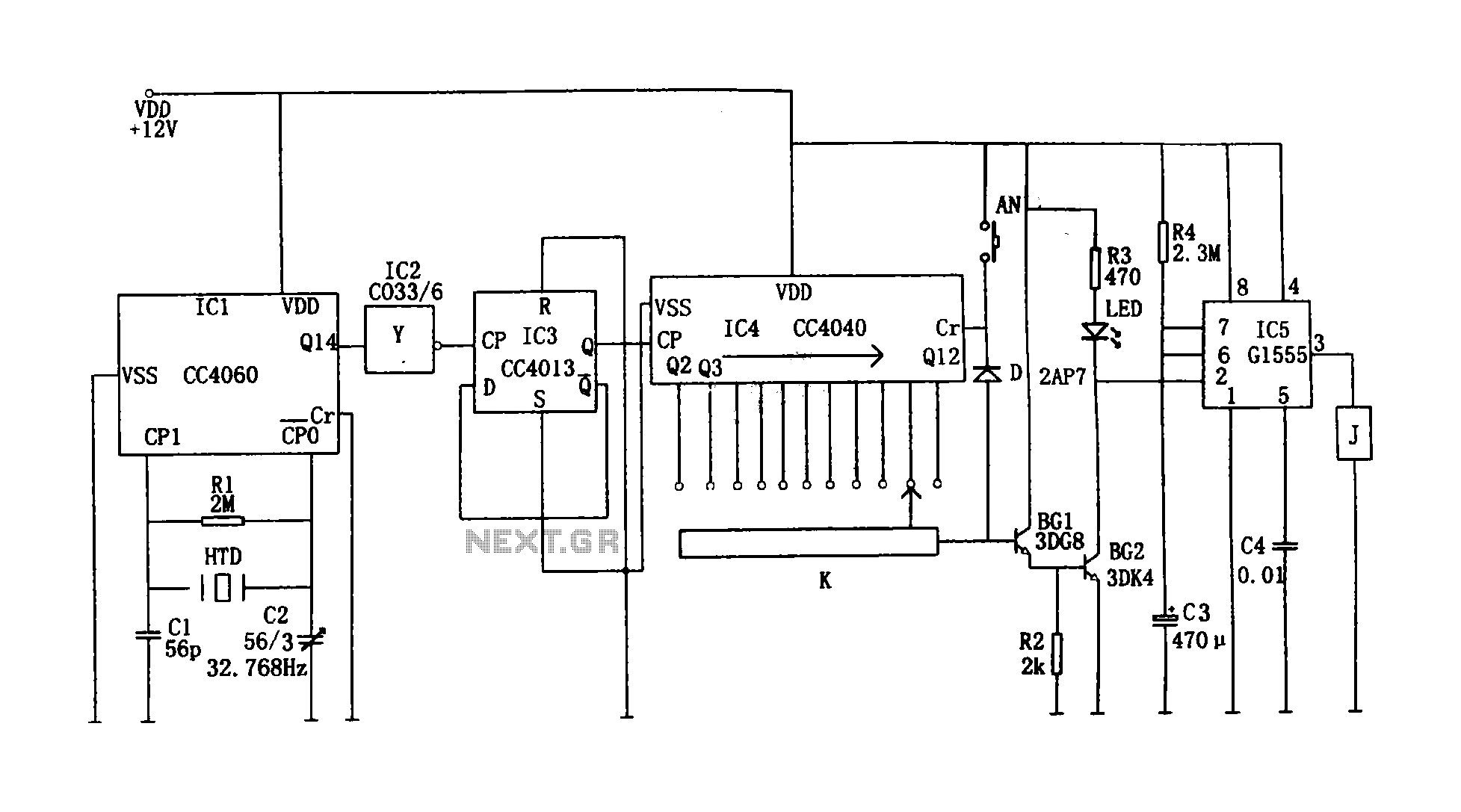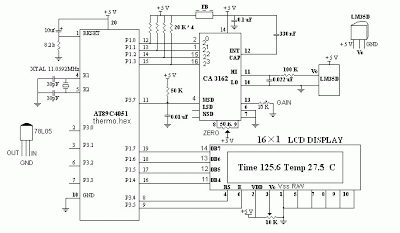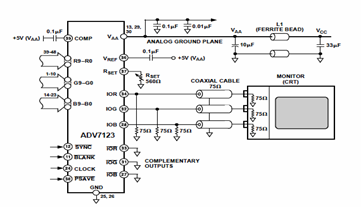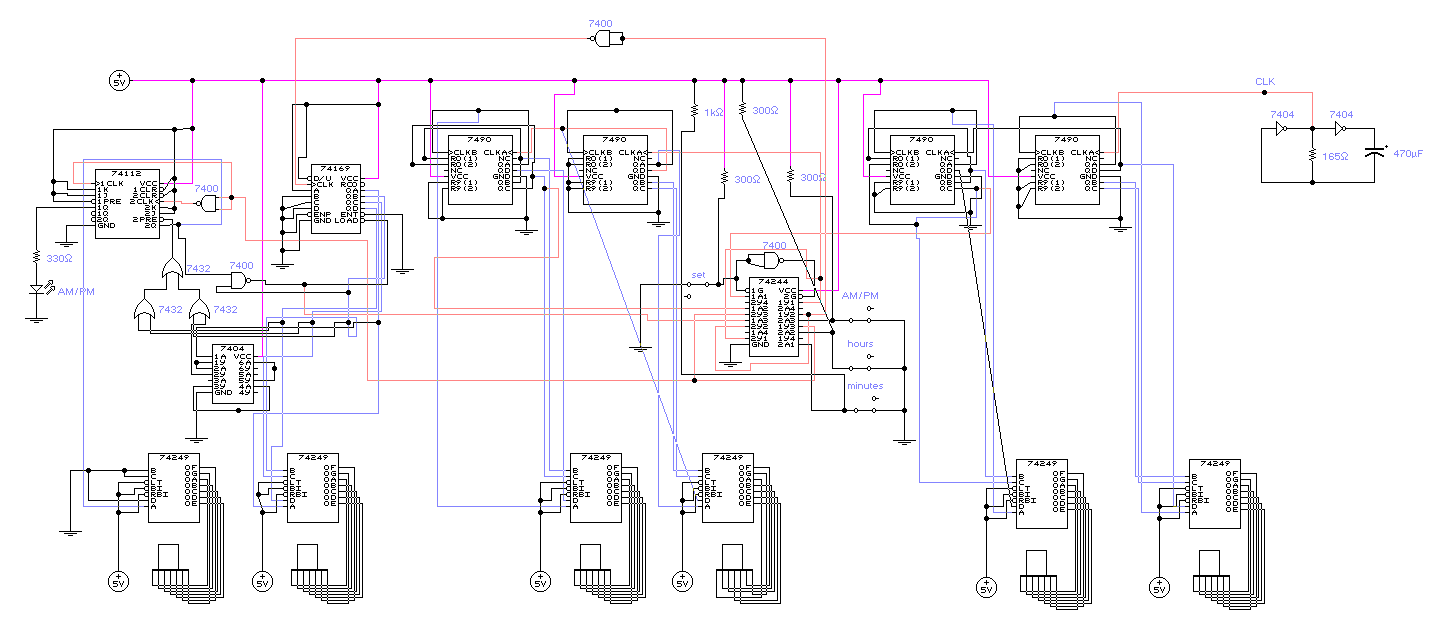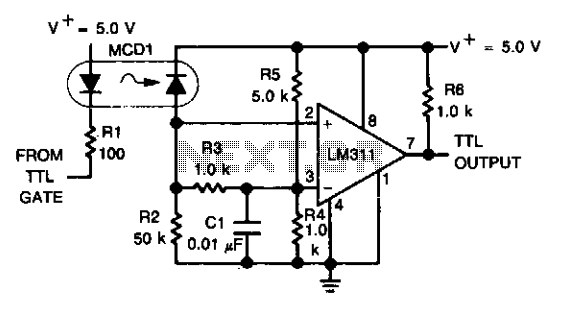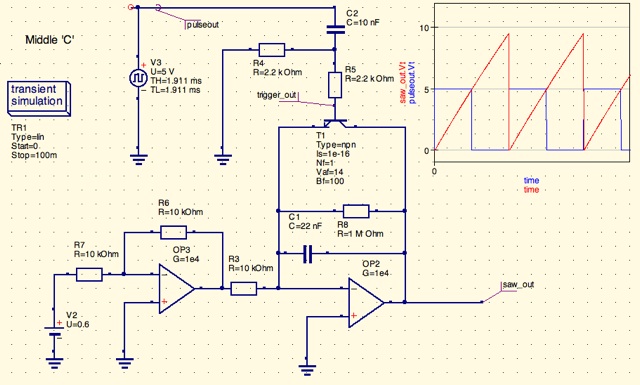
Digital Theremin
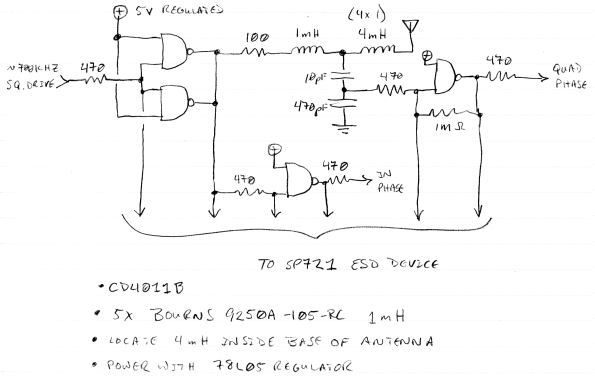
The circuit mentioned is significantly less effective than Lev's Oscillator for Theremin applications. The simulation waveforms indicate the red sine wave represents the voltage on L1:A, the black sine wave indicates the voltage on Q1:D, and the blue square wave shows the current through L1:B and Q1, averaging around 10mA and 5mA respectively. This current flows through the "tickler" winding, which has low resistance and inductance (100mΩ and a maximum of 39µH), minimizing thermal and other potential issues. The circuit has not been physically constructed or tested in its current form, but the FET model used is a reliable one from a reputable manufacturer. It is advisable to review this schematic in conjunction with data on the RCA. The waveforms from the initial filters indicate that while differential outputs have been generated, they are not strictly necessary; one could directly utilize the lower R4(2) signal. By differentially combining the signals and enhancing the filtering at the operational amplifier, clean audio output can be achieved (demonstrated with input signals of 170kHz and 172kHz, resulting in a 2kHz audio output). Additionally, the 4-6 winding can be added in series with other windings to extend the range, potentially around 50µH. However, the tickler in this design has a notably lower inductance compared to the RCA, where the inductance is approximately 170-180mH. The RCA oscillator coils are wound in two layers, one atop the other, while the diagram for the 421F106 suggests a single winding with multiple tap points. It has been noted that these differences could subtly affect tone. The recommended winding configuration is 76 turns of #26 magnet wire on a 1.5" form, with two layers separated by a 0.03" layer of fabric, yielding an inductance of about 170mH for the inner layer and 178mH for the outer layer, with a resistance of approximately 1.6 ohms. Although rewinding is theoretically possible, it poses risks due to the small size of the components and the brittleness of the ferrite. The oscillator schematic presented is quite different from the RCA, particularly concerning the characteristics of L1. The simulation was created as a preliminary evaluation of the Armstrong oscillator, and it is believed that the tickler winding (L1:B) should have minimal impact. The key requirement is to match the values of L1:A and tank capacitance C2 to those of the RCA to ensure similar responses to antenna capacitance via the antenna EQ circuit. The respective values of the tank resonator and antenna resonator should dictate this, which is why they have been kept consistent with the RCA. Adjustments can be made for EW frequencies by changing the values of L1:A and C2, as well as replacing the antenna EQ values accordingly.
The circuit described functions as an oscillator specifically designed for Theremin applications, utilizing a feedback mechanism to maintain oscillation. The configuration includes an inductor (L1:A), a feedback winding (L1:B), and a tank capacitor (C2), which collectively define the resonant frequency of the oscillator. The choice of inductance and capacitance values is critical, as they determine the oscillator's response to external signals, particularly from an antenna.
The operational amplifier is used to refine the output signal, enhancing audio clarity by filtering unwanted frequencies. The differential output mode is a design choice that can provide improved noise rejection, although simpler configurations can achieve satisfactory results without this complexity. The mention of using a specific number of turns of magnet wire indicates a careful consideration of the winding parameters, which directly influence the inductance and resistance characteristics of the oscillator.
The ability to modify the circuit for different frequency ranges (such as EW frequencies) showcases its versatility, allowing for adjustments in inductance and capacitance to accommodate various applications. The construction of the inductor, particularly the winding technique and layer separation, plays a significant role in achieving the desired inductance values while minimizing losses due to resistance.
Overall, the circuit's design emphasizes the importance of matching component values to ensure optimal performance, while also highlighting the challenges associated with constructing and modifying such sensitive electronic components.The above circuit, whilst it works, is GREATLY INFERIOR to Lev`s Oscillator for Theremin use. The above simulation waveforms - Red Sine = voltage on L1:A, Black Sine = Voltage on Q1:D, Blue square wave is current through L1:B and Q1 (10mA, 5mA average) It should be noted that this current is through the "tickler" winding which has low R and L (100mR and 39uH max) so thermal and other problems should be minimal. Not physically built or tested in this form, but FET model is a good manufacturer supplied one which I have found reliable. Best to look at this schematic together with data on the RCA. Waveforms from first filters - Note, differential outputs have been genersted, but this is not strictly needed - one could take the lower [R4(2)] signal and use this directly: And finally - differentially combining the signals, and sharpening the filtering at the opamp, one gets clean audio (the above is shown with 170kHz and 172kHz input signals, giving 2kHz audio out: One can also add the 4-6 winding to any others giving additional range (for example, add 4-6 in series with 2-3 to extend somewhere around 50uH to this range available.
great work!. but it appears the your tickler has a much lower inductance- whereas in RCA they are about the same. 170-180(ish) mH. and the RCA osc coils windings are in two layers with one on top of the other. The diagram for the 421F106 leads me to conclude that is is a single wind with multiple tap points. Fred, Im no engineer (should be my signature!) but couldnt these differences have an effect, albeit a subtle one, on the tone I dont think that I saved it, (and I may be wrong) but I recall another, or possibly followup email where Uncle Howie recommended against changing the coils at all. 76 turns of #26 magnet wire on a 1. 5" form X 2 layers (with about. 03" layer of fabric seperating layers. ) w inductance @ about 170mH for inner layer, 178mH for outer and resistance of about. (wait let me check. ) 1. 6 ohms Rewinding it is, in theory, possible, but these things are TINY. The wire is very thin and the ferrite is brittle. Messing with it just invites disaster. I`ve been winding inductors for almost half a century, and I don`t want to fiddle with these. You are absolutely correct - My Osc schematic bears little resemblance to the RCA - particularly with regard to the charactaristics of "L1".
I simply knocked this simulation together as a quick first thought for evaluating the Armstrong oscillator. As I see it, the "tickler" winding (L1:B) should have little impact - but I could be completely wrong about this.
my view is that, as long as it is capable of maintaining the required feedback to keep the oscillator oscillating, anything would work. As I see it, the critical requirement is to get the value of L1:A and the tank capacitance C2 the same as the RCA if one wants the circuit to respond to antenna capacitance (via the antenna EQ circuit) the same way as an RCA.
It is the respective values of the tank resonator and the antenna resonator which should determine this - so I have kept these the same as the RCA. This oscillator could be changed to work at EW frequencies by changing the values of L1:A (using pins 2-3 rather than pins 1-3 for L1:A)and C2, and replacing the antenna EQ values to those on the EW, for example.
It is only because Uncle Howie seems to think the oscillator design is critical (as 🔗 External reference
The circuit described functions as an oscillator specifically designed for Theremin applications, utilizing a feedback mechanism to maintain oscillation. The configuration includes an inductor (L1:A), a feedback winding (L1:B), and a tank capacitor (C2), which collectively define the resonant frequency of the oscillator. The choice of inductance and capacitance values is critical, as they determine the oscillator's response to external signals, particularly from an antenna.
The operational amplifier is used to refine the output signal, enhancing audio clarity by filtering unwanted frequencies. The differential output mode is a design choice that can provide improved noise rejection, although simpler configurations can achieve satisfactory results without this complexity. The mention of using a specific number of turns of magnet wire indicates a careful consideration of the winding parameters, which directly influence the inductance and resistance characteristics of the oscillator.
The ability to modify the circuit for different frequency ranges (such as EW frequencies) showcases its versatility, allowing for adjustments in inductance and capacitance to accommodate various applications. The construction of the inductor, particularly the winding technique and layer separation, plays a significant role in achieving the desired inductance values while minimizing losses due to resistance.
Overall, the circuit's design emphasizes the importance of matching component values to ensure optimal performance, while also highlighting the challenges associated with constructing and modifying such sensitive electronic components.The above circuit, whilst it works, is GREATLY INFERIOR to Lev`s Oscillator for Theremin use. The above simulation waveforms - Red Sine = voltage on L1:A, Black Sine = Voltage on Q1:D, Blue square wave is current through L1:B and Q1 (10mA, 5mA average) It should be noted that this current is through the "tickler" winding which has low R and L (100mR and 39uH max) so thermal and other problems should be minimal. Not physically built or tested in this form, but FET model is a good manufacturer supplied one which I have found reliable. Best to look at this schematic together with data on the RCA. Waveforms from first filters - Note, differential outputs have been genersted, but this is not strictly needed - one could take the lower [R4(2)] signal and use this directly: And finally - differentially combining the signals, and sharpening the filtering at the opamp, one gets clean audio (the above is shown with 170kHz and 172kHz input signals, giving 2kHz audio out: One can also add the 4-6 winding to any others giving additional range (for example, add 4-6 in series with 2-3 to extend somewhere around 50uH to this range available.
great work!. but it appears the your tickler has a much lower inductance- whereas in RCA they are about the same. 170-180(ish) mH. and the RCA osc coils windings are in two layers with one on top of the other. The diagram for the 421F106 leads me to conclude that is is a single wind with multiple tap points. Fred, Im no engineer (should be my signature!) but couldnt these differences have an effect, albeit a subtle one, on the tone I dont think that I saved it, (and I may be wrong) but I recall another, or possibly followup email where Uncle Howie recommended against changing the coils at all. 76 turns of #26 magnet wire on a 1. 5" form X 2 layers (with about. 03" layer of fabric seperating layers. ) w inductance @ about 170mH for inner layer, 178mH for outer and resistance of about. (wait let me check. ) 1. 6 ohms Rewinding it is, in theory, possible, but these things are TINY. The wire is very thin and the ferrite is brittle. Messing with it just invites disaster. I`ve been winding inductors for almost half a century, and I don`t want to fiddle with these. You are absolutely correct - My Osc schematic bears little resemblance to the RCA - particularly with regard to the charactaristics of "L1".
I simply knocked this simulation together as a quick first thought for evaluating the Armstrong oscillator. As I see it, the "tickler" winding (L1:B) should have little impact - but I could be completely wrong about this.
my view is that, as long as it is capable of maintaining the required feedback to keep the oscillator oscillating, anything would work. As I see it, the critical requirement is to get the value of L1:A and the tank capacitance C2 the same as the RCA if one wants the circuit to respond to antenna capacitance (via the antenna EQ circuit) the same way as an RCA.
It is the respective values of the tank resonator and the antenna resonator which should determine this - so I have kept these the same as the RCA. This oscillator could be changed to work at EW frequencies by changing the values of L1:A (using pins 2-3 rather than pins 1-3 for L1:A)and C2, and replacing the antenna EQ values to those on the EW, for example.
It is only because Uncle Howie seems to think the oscillator design is critical (as 🔗 External reference
Warning: include(partials/cookie-banner.php): Failed to open stream: Permission denied in /var/www/html/nextgr/view-circuit.php on line 713
Warning: include(): Failed opening 'partials/cookie-banner.php' for inclusion (include_path='.:/usr/share/php') in /var/www/html/nextgr/view-circuit.php on line 713
